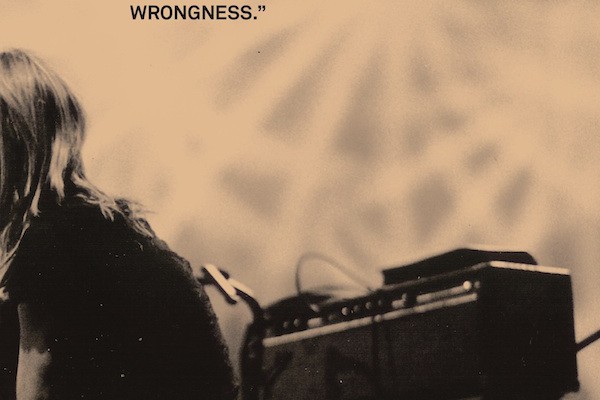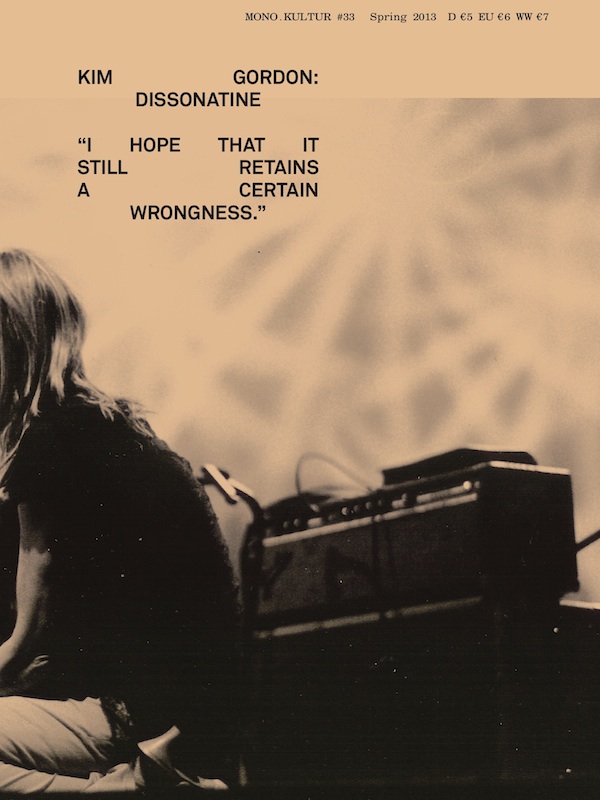
Her long-term friend and collaborator Jutta Koether, once wrote that artist and musician Kim Gordon is “if at all, a fragile super special chick (based on a decision), who plays bass, pushes for improvisation, one who knows and loves the history of the chicks in music and by that obviously serves as a very complex role model.”[i] For a long time, this is what made Kim Gordon appear like a defining figure of ‘cool’ to many, not only for being one of the first women to play in the otherwise all-male rock band, Sonic Youth, but also for her self-reflexive, increasingly conscious assumption of exactly this role. As is common in rock star figures, it has been difficult to separate her artistic output from her persona, and for this she has been receiving increasing attention, as well as institutional and academic recognition as a solo artist since the unofficial breakup of the cult band in 2011. In addition to reflecting her personal achievements, this recognition also demonstrates that an artistic practice strongly related to sub-, niche- and alternative music culture today has become accessible to and assimilated into art-historical frameworks. How did this pan out in relation to the figure of Gordon?
In the spring of 2013, Berlin-based, independent magazine mono.kultur chose a fanzine-like style for their “Dissonantine” issue dedicated to Gordon. [ii] One of the primary reasons the editors devoted an issue to her was to foreground the fact that she serves as an idol. In each issue, the magazine is structured around an extended interview with singular figures from the cultural field. The design varies depending on the content, but the DIN A5 format always remains the same. This particular issue on Gordon is made up of a loose assemblage of images from different stages in her career, installation shots of recent exhibitions of her artwork, as well as concert shots, quotations from previous interviews, drawings, lyrics, and a portrait taken before the interview that I myself conducted. The hierarchies between the elements in the four-page text, with separate images and quotes, are dismantled to reflect Gordon’s own use of different formats and media, deeply rooted in and influenced by a Do-It-Yourself approach, which itself was rooted in punk culture. Even though mono.kultur is produced with very little means, it is not “self-produced” in the original meaning of the term; rather, the designers of the Gordon issue appropriated a DIY-aesthetics typical of fanzines. It references a style once associated with an anti-consumerist attitude dating back to the beginnings of the punk movement in the mid-1970s—a movement that has itself become ‘historical’ and by now largely commodified. Moreover, contrary to classical fanzines, mono.kultur’s audience is much larger and not necessarily constituted by a particular category of fans. And lastly although zines were often distributed at concerts, record shops, and shared hand to hand among friends and fans who formed a community of like-minded people, mono.kultur is an institutional publication for sale in independent bookshops and other similar venues.
In November 2013, New York’s renowned venue for experimental music, Issue Project Room, dedicated their ten-year anniversary benefit to “the legendary artist Kim Gordon”, honoring her with two nights of concerts that celebrated her recent collaborative work with, among others, I.U.D., an all-female industrial duo formed by Lizzi Bougatsos (Gang Gang Dance) and Sadie Laska (Growing), detaching her musical output from that of Sonic Youth. This year, Isabelle Graw and Daniel Birnbaum from the Institute for Art Criticism published selected texts by Gordon under the title Is It My Body?, titled and edited by Branden Joseph for their series at Sternberg Press.[iii] In the volume’s foreword, Graw and Birnbaum frame the book as an instant classic. The selected texts range from tour diaries to essays exploring the intersections and hangouts of New York’s art and music scene, and the sexual implications of rock music. Gordon’s selected texts can be seen as successors of Dan Graham’s Rock My Religion: Writings and Projects 1965–1990, originally published in 1993, but also the writings of Koether, John Miller, and Mike Kelley—all of whom in one way or another are interconnected with other artists from a background in punk culture and who work across fixed boundaries.

In Graham’s 1981 seminal text on women in rock music, “No Wave Rock and the Feminine,” he remarkably starts with a quote by Gordon, as he was the one who originally encouraged her to start writing instead of merely producing work for gallery spaces. “You had to be part not just of a painting dialogue,” Gordon remembers, “but of a more widespread and interesting cultural dialogue.”[iv] For Gordon, who was trained as an artist in the late 1970s, turning to music also implied more independence. It promised a freedom of expression outside the gallery system and the pressure to sell well. “Before picking up a bass,” she wrote in her tour diary in 1987, “I was just another girl with a fantasy,” and “for my purpose, being obsessed with boys playing guitars, being as ordinary as possible, being a girl bass player is ideal, because the swirl of Sonic Youth music makes me forget about being a girl. I like being in a weak position and making it strong.” [v] Gordon has worked across a series of media, activities and formats while displaying an awareness of the apparatuses she works within, as is also evidenced in her writings. This can also be read as symptomatic of a late avant-garde in New York City, in particular from the late 1970’s until the early 1990’s, which allowed for both the creation of a community of fans as well as an awareness of how those artistic mechanisms create categories of fandom.
In another register, the noise-rock band Sonic Youth, which itself grew out of this context in 1981, functioned more and more like a support structure for the work of befriended artists and musicians with whom they had toured over time. In this, they established a signature aesthetic that would become emblematic of a whole generation. Then non-established artists like Kelley or Raymond Pettibon, as well as well-established artists like Gerhard Richter, contributed work to their record covers, video artist Tony Oursler, and filmmakers Spike Jones and Tamra Davies collaborated with them on their videos.
A homage exhibition to the band in 2008 and 2009, demonstrating these interactions and crossovers. Sonic Youth etc.: Sensational Fix traveled throughout major art institutions in Europe. Sensational Fix, can be read as a demonstration of and emphasis on the band’s collaborative, experimental, and multidisciplinary character, with collaborations with filmmakers, artists, designers, and musicians stood side by side with artworks selected by Sonic Youth.[vi] Ironic, as the exhibition as well as the catalogue, which includes two 7-inch records, in the end appeared to be the most adequate format to present the band’s work and the scene for which it stands. The exhibition not only functioned as a mode of presentation, but also mode of representation that the usual concert, for example, couldn’t offer. Even if Gordon claims, that “it wasn’t meant to be a Sonic Youth show, not a show about Sonic Youth,” [vii] it especially retrospectively appears like a final display of what Sonic Youth had achieved before breaking up. The interdisciplinary show attempted to tell “an alternative story of contemporary culture, of teenager rebellion, the restlessness of youth, of the craving for fame and the search for identity, gender roles, sexuality, and religion”. [viii] This is an agenda that fits perfectly into the recent trend of music, pop and subculture related exhibitions.[ix] Interestingly however, no US institution was willing to take on the Sonic Youth show—evidence that the band always had its biggest fan base in Europe, a large part of which is constituted by fans with some kind of visual art affiliation, and many of whom would become curators.
Following her involvement with Sonic Youth, Gordon not only started her noise project with Bill Nace Body/Head, but as we’ve been arguing, became more visible in the art world. She exhibited her drawings and painted objects in a three-person show at Mathew Gallery in Berlin in spring of 2012 accompanied by a performance at a local bar next door. A few months later she was involved in a group show with Karen Kilimnik at 303 Gallery in New York. While she once picked up the guitar to leave the art world, the art world, with its particular institutional structures, now significantly seemed to be the more accommodating place for her to return. What once didn’t fit a given market, now (thanks to her persona) found its place therein. It is yet to be seen how the figure of Gordon will tackle questions of format and institutions, and their concomitant associations with fandom in future articulations of her multidisciplinary practice.